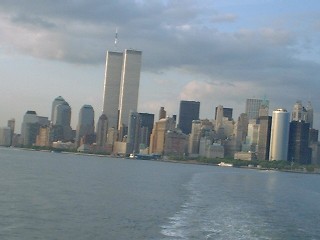
This essay, published on Thursday, September 11, 2014, is exclusive to Notablog.
[REMEMBERING THE WORLD TRADE CENTER: 2001; 2002; 2003; 2004; 2005; 2006; 2007, 2008, 2009, 2010, 2011, 2012, 2013, 2014, 2015, 2016; 2017; 2018; 2019; 2020; 2021]
A MUSEUM FOR THE AGES:
A PICTORIAL
By Chris Matthew Sciabarra

The Twin Towers, from the Staten Island Ferry, May 12, 2001
On Wednesday, August 27, 2014, I returned for the first time in two years to the site of the World Trade Center (WTC), which now houses the National September 11 Memorial and Museum, commemorating the horrific events of September 11, 2001.
The first significant change I noticed was that the Memorial itself, marking the footprints of where the Twin Towers once stood, is open on all sides, allowing free access to all visitors. Security check points are gone; they have now been re-located to the actual Museum, which charges a fee for entrance. This year, in keeping with my annual tribute, "Remembering the World Trade Center," I provide a pictorial of my visit to the 9/11 Memorial Museum.
The photos below were taken by either my sister Elizabeth or me. The main floors provide a sense of the grandeur that was once the Twin Towers: spacious, open, creative. And yet, It seems as if the more one descends into this extraordinary Museum, the more one descends into the deepest rings of a real-llfe Dante's Inferno; the most emotionally wrenching aspect of the museum was off limits to photography. It is not hard to figure out why. The reflective pools above mark the footprints of the North and South Towers, and provide one with an opportunity for placid moments of quiet reflection, in honor of the nearly three thousand who perished. By contrast, the Museum below is quite literally a descent into a hellish abyss. Here, the Museum tells the story in all of its nightmarish details. At the Museum's core is a claustrophobic exhibit that chronicles the actual 102 minutes of the events that began on a beautifully clear late summer morning, whose blue skies were soon blackened by the worst attack on American soil in United States history. We are led from 8:46 am, when the first plane, American Airlines Flight 11, hit the North Tower until 10:28 am, when that Tower collapsed. It follows the events systematically, and includes film and artifacts tracing the hit of the South Tower by United Airlines Flight 175 (at 9:03 am, and its collapse at 9:59 am), the attack on the Pentagon at 9:37 am (by American Airlines Flight 77), and the battle for United Airlines Flight 93, which crashed at 10:03 am, into a field in Stoneycreek Township, Pennsylvania, largely a result of the attempts of heroic passengers who attempted to wrest control of the cockpit. Indeed, if there were a single moment of inspiration, it came from the sounds of struggle heard on that flight, when passengers stormed the cockpit, while barbaric Islamic savages proclaimed "Allah is the greatest," nosediving the plane into that Pennsylvania field.
Words cannot possibly capture the overwhelming emotions that visitors experience in this Chamber of Horrors: from grief and sorrow to anger and rage. I felt that whole array of emotions, crying effortlessly at the sounds that bombarded me from all directions---the voices of confused air traffic controllers as the airspace across the country was closed; the sounds of voice mail messages left by individuals who knew their lives were doomed and who consoled their loved ones to go on living with the knowledge that they were loved; the sounds of beepers, relentlesssly pinging to alert those in search of the living and the dead who were buried beneath the rubble. Here in this exhibit, it is history as if it were in real-time:
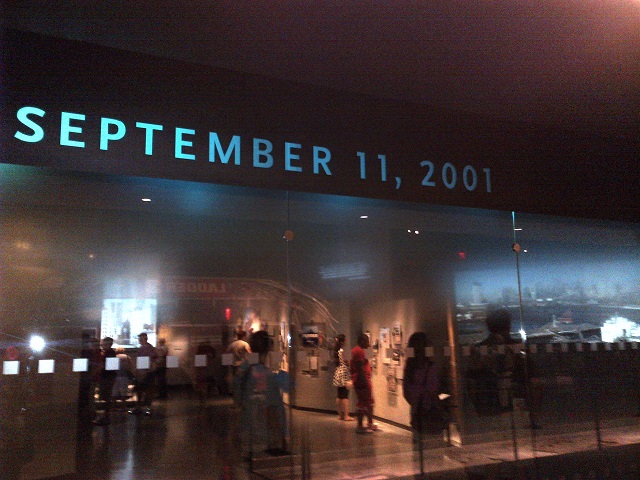
Here is a map of the timeline of
crashes:
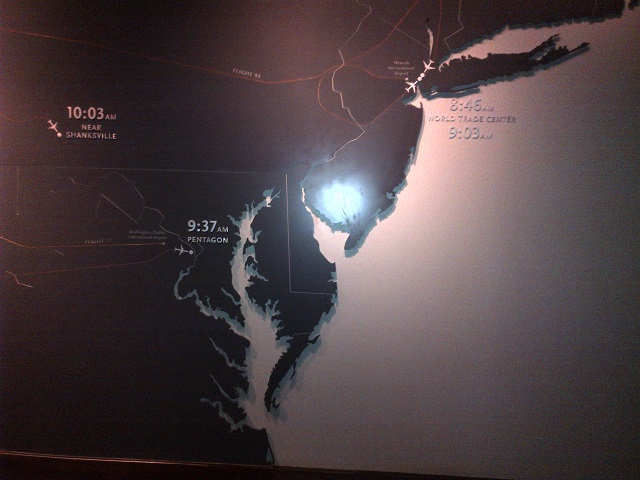
Before entering the Memorial and the Museum, however, I was struck by the remarkable growth taking place around Ground Zero. The centerpiece of the reconstruction is 1 World Trade Center, or the Freedom Tower as it was first called. It stands like a Giant Middle Finger flipped at those who would rob us of our liberties and our lives. It tells those who would tear down our city that we will not cower in the face of terror. We will not be denied life, activity, trade, and the magnificent skyline that is New York City, still a marvel of the modern world. The three photos below (from right to left) show 1 World Trade Center exclusively; then, a broader photo of its place in the growing downtown Manhattan skyline; and finally, there is 4 World Trade Center.
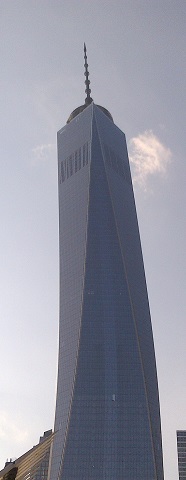 |
 |
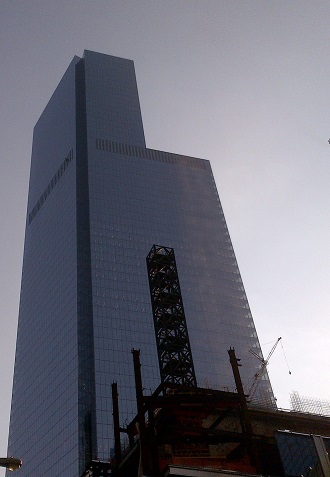 |
Among the other structures under construction is the Transportation Hub (photo left). As one enters the site, one sees the glory of architectural imagination that is guiding the rebirth of downtown Manhattan (photo right).
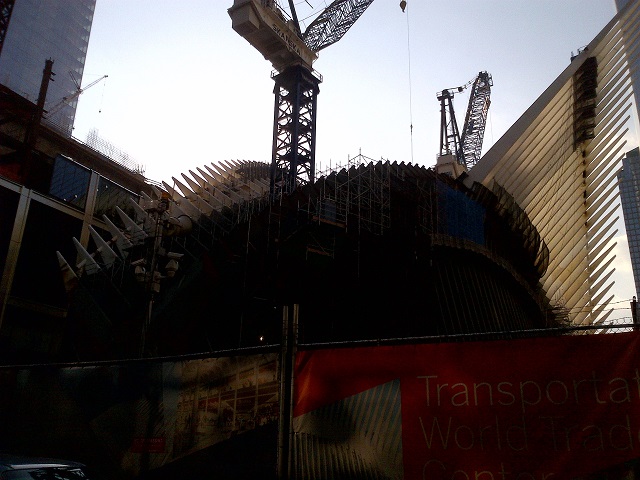 |
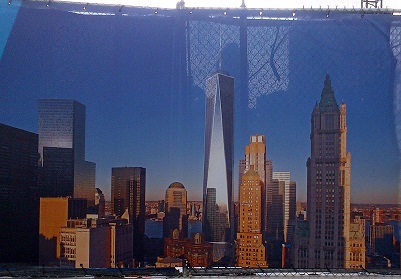 |
The site declares "Hello, Tomorrow: We never forget what had gone before. Yet our eyes have always been on the possibilities ahead for downtown Manhattan (photo right). As one walks toward Ground Zero, one follows directions toward an experience of almost indescribable sorrow.

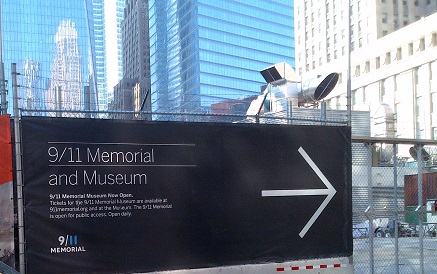
Passing various monuments along the way, including the pools that mark the footprints of the North and South Towers, with victims' names engraved along each perimeter, one finally reaches the Museum (the three photos below):
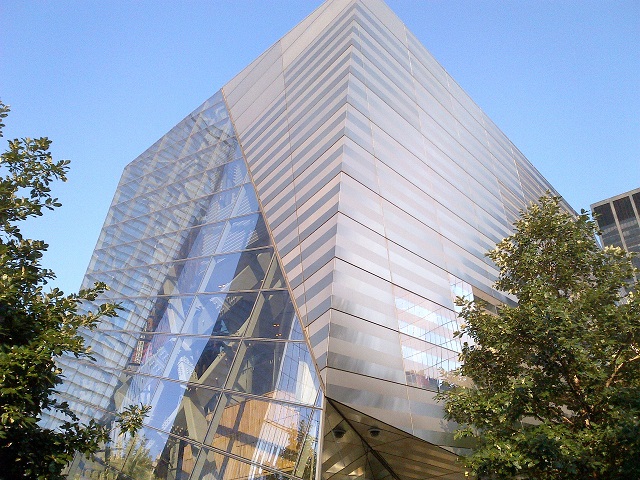
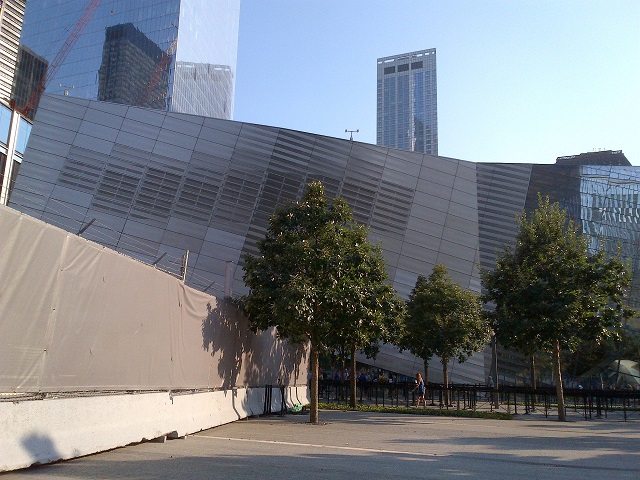
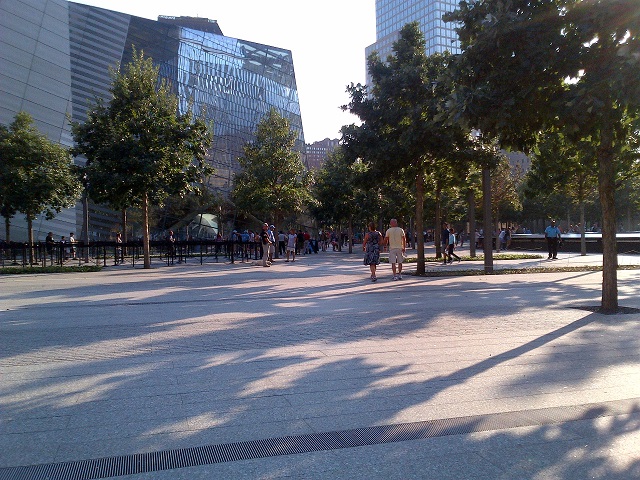
Inside the Museum, we are greeted with the sounds of voices from people across the world, telling us where they were on the morning of September 11, 2001. Visitors are invited to record their own testimonial in another section of the facility.
Among the first things one sees, is a startling image: the architectural wonders of the Towers' steel beams, now twisted into archaeological artifacts:
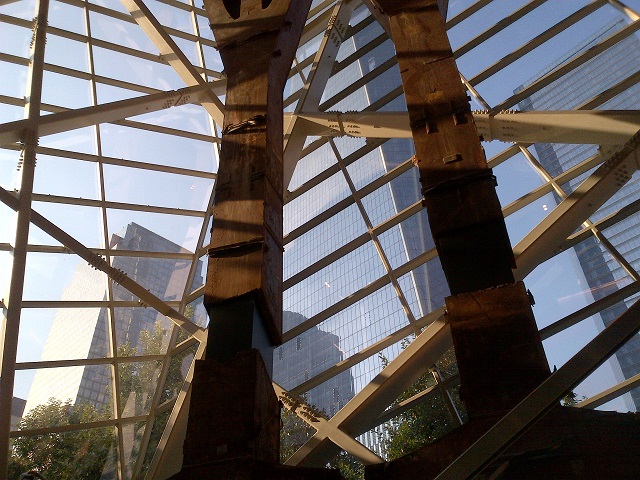
This piece of steel (below) was from the north side of the North Tower, at the point of impact, at the 93rd through the 99th floor (my cousin Scott was on the 89th floor, surviving miraculously):
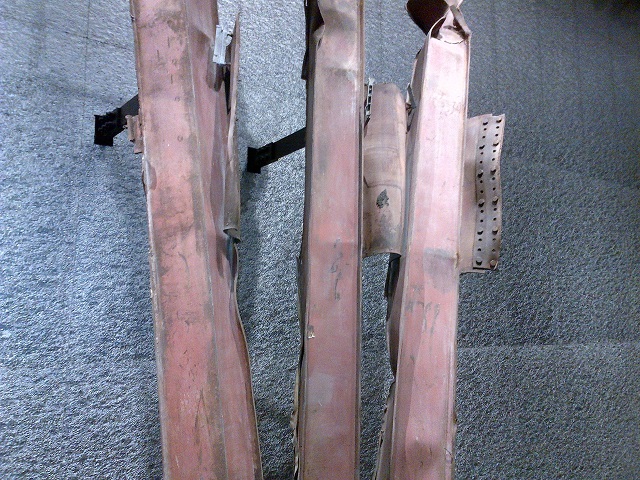
Also from the North Tower, there is this remnant of the antenna (photos taken from different angles):
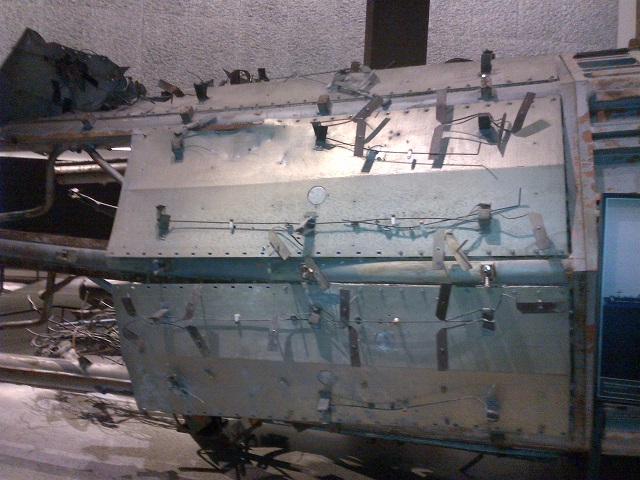 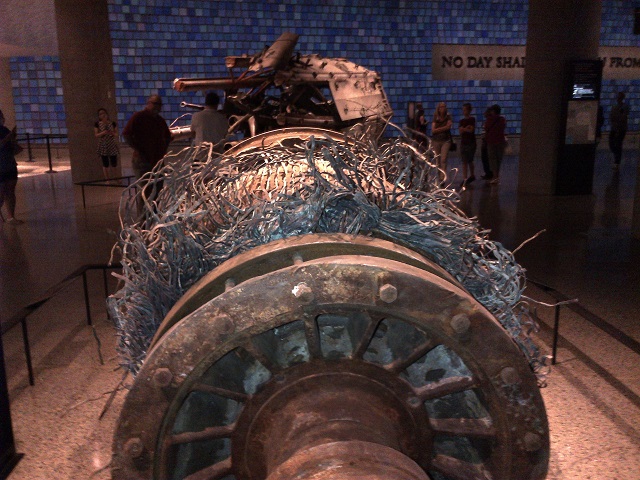 |
The exhibit also features the Dedication Day cornerstone, dated April 4, 1973, when the Twin Towers officially opened with a ribbon-cutting ceremony:
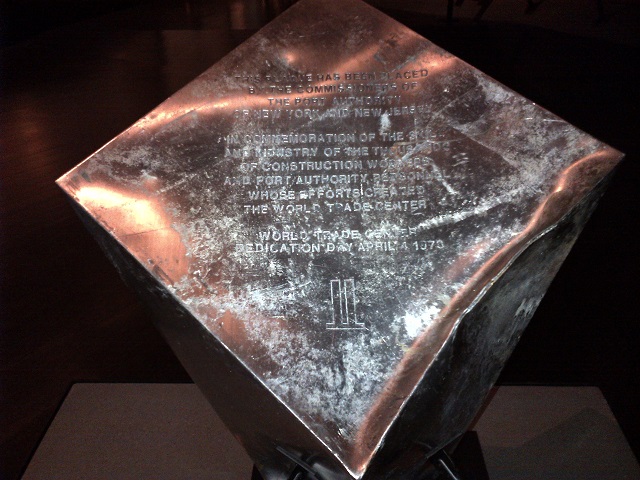
The Last Standing Column from the Twin Towers was recovered at the end of May 2002 and is on display at the museum; it is signed by many of those who worked in "The Pit" and includes remembrances of those who lost their lives in the attack (photo left). The exhibit aso features a truck from the FDNY's Laddder Company 3, which lost nearly all of its men (photo right). And then, there is the "Slurry Wall" (photo not included), that was built at the foundation of the towers to hold back the waters of the Hudson River; it achieved its function despite the pancaking collapse of two of the tallest buildings in the world.
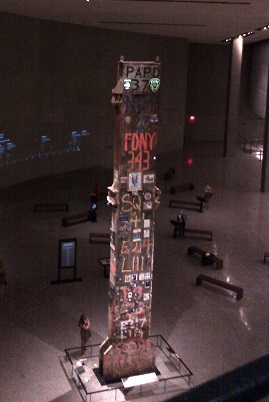
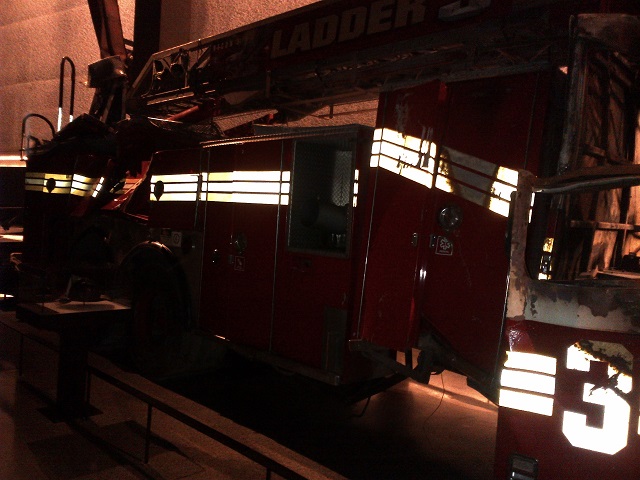
Images of the posters that were pinned to poles and buildings all across lower Manhattan tell the story of the search for loved ones, many of whose remains have never been found or identified:
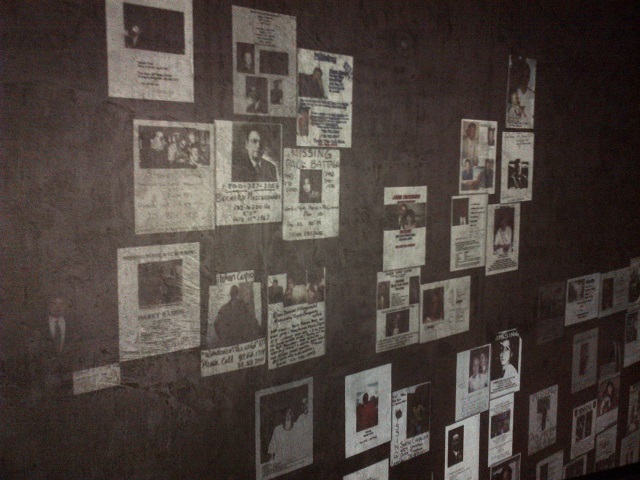
The Suvivors' Staircase is also preserved at the Museum; it was one of the few remaining structures from the WTC site; it served as an escape route for hundreds of people who evacuated the site before the collapse of the Towers.
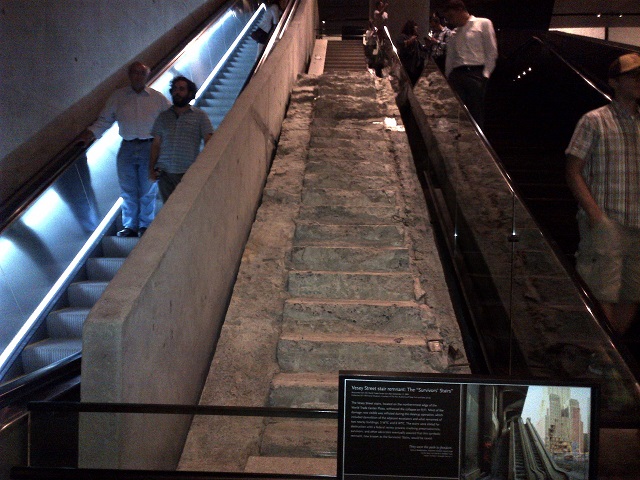
As we departed the Memorial grounds, we took this photo of the South Tower footprint, at dusk, its waters bathed in light:
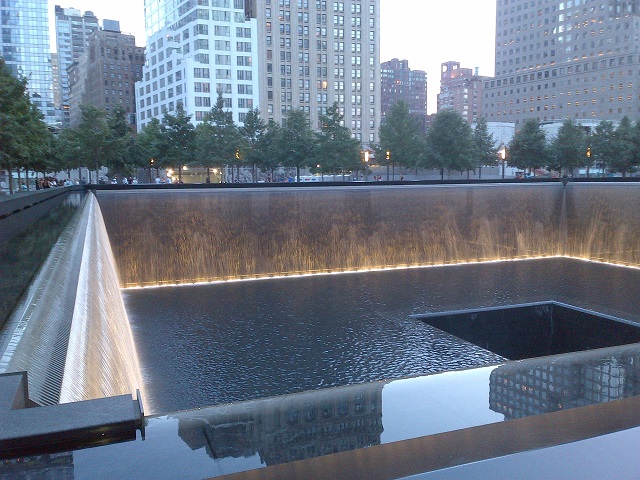
I close this pictorial tribute with one of the most moving quotations on the walls of the 9/11 Museum; it is from the writings of Virgil, and captures the spirit of the exhibit: "No Day Shall Erase You From the Memory of Time":
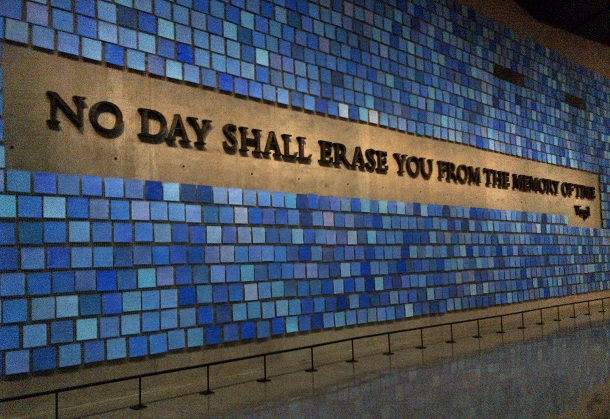
9/11 has forever altered the lives of everyone who lived through it. This museum offers an exhibit of heartbreaking contrast. As much pain as it evokes, so too does it offer inspiration for the future. It does so with a profound sensitivity to those who lost their lives, and to those who still mourn. As long as I shall live and maintain this blog, I will continue to mark this day as one that will never be erased from the memory of time.
 |
 |